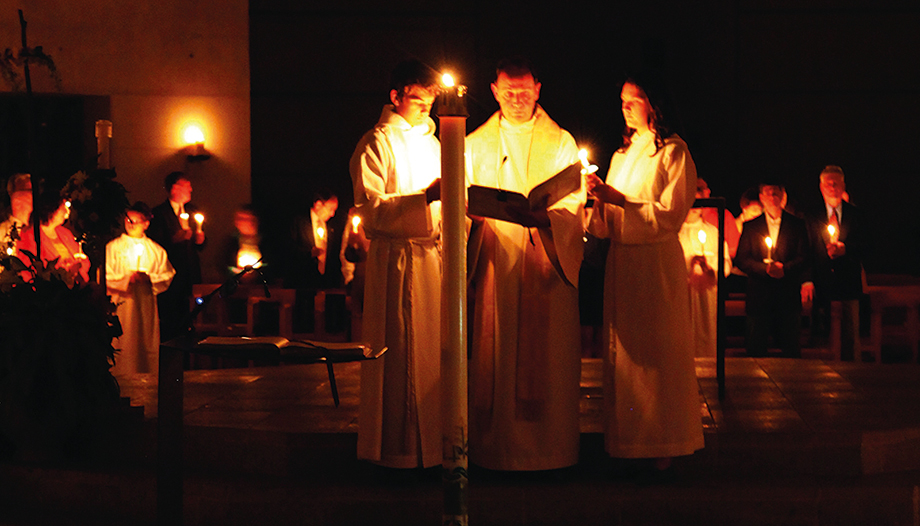 The road to Easter
The road to Easter The title of the second Easter preface (De vita nova in Christo) directs our gaze to the effects of Christ's Passover in the life of believers. Indeed, through Christ's sacrifice on the cross, the children of light are born to eternal life and the gates of the kingdom of heaven are opened to believers.
The expression sons of light refers to Lk 16:8, but above all to Jn 12:36: "While you have the light, believe in the light, that you may be sons of light," and indicates those who believe in the divinity of Christ. In fact, the passage from John cited deals with the ultimate revelation given by the voice of the Father from heaven ("Father, glorify your name. Then came a voice from heaven: 'I have glorified him and will glorify him again'" (Jn 12:28) and that offered by the Paschal Mystery ("And I, when I am lifted up from the earth, will draw all men to myself" (Jn 12:32): Christ is the light of the world because he is the only-begotten Son of the Father, as the voice from heaven and the Cross reveal; only by believing in him does one become a child of light and a new world is born, characterized by eternal life.
The expression "eternal life" does not designate in the first place life after death, but new life in Christ: only God is eternal and therefore only the life of God is eternal; in this sense, "eternal life" is synonymous with the life of God. Indeed, faith in Christ crucified and risen and the sacramental life allow God to dwell in the believer; in this way the life of grace is manifested, which is nothing other than the divine life in us. Thus we understand what Jesus means when he says: "He who believes has eternal life (...) He who eats my flesh and drinks my blood has eternal life, and I will raise him up on the last day" (Jn 6:47-54). oriunturwhich refers precisely to the beginning of a new day.
Moreover, the gates of paradise, which had been closed as a consequence of original sin (Gen 3:23-24), have been reopened thanks to the death and resurrection of Christ: communion with God is once again possible and the original plan of salvation is once again within everyone's reach. However, the Preface stresses that this is possible for the faithful (fidelibus): thanks to Baptism we are immersed in the death and resurrection of Christ and, therefore, we can enter into communion with Him and enjoy the eternal life that God communicates to us.
Finally, the preface cites the Pauline doctrine of Christ's death as the cause of our redemption and his resurrection as the cause of ours. This is what St. Paul expounds in Rom 5, 10-17 and 2 Cor 5, 14-15: "For the love of Christ possesses us; and we know that one died for all, therefore all died. And he died for all, so that those who live might live no longer for themselves, but for him who died for them and rose again."
Third Preface: Christ's continuing mediation
The third preface focuses on the ongoing mediation of Christ, the effect of his resurrection. In fact, the title (De Christo vivente et semper interpellante pro nobis) quotes Heb 7:25: "Therefore he is able to save those who draw near to God through him, since he is always alive to make intercession for them". This is the proper condition of Christ, who by virtue of the resurrection in the first place can no longer die, death no longer has power over him (Rom 6:9); he is the Living One, the one who lives forever, according to the vision of the Apocalypse: "I am the First and the Last, and the Living One. I was dead, but now I am alive forevermore".
However, this condition of his does not distance him from us, as it might seem, since we are characterized precisely by finiteness. His eternal life is, in fact, a life constantly given for us, his brothers and sisters: he is the Lamb sacrificed for our salvation. He is the Lamb sacrificed for our salvation, sacrificed once and for all, but who at the same time continually intercedes for us.
Indeed, seated at the right hand of the Father, he did not renounce his role as mediator: Christ's priesthood is an eternal priesthood and he is the only mediator of the new and eternal covenant. This is one of the most significant characteristics of Christ's priesthood: while in the Old Testament victim and priest were necessarily distinct, in the New Covenant they coincide.
Eternal priesthood of Christ
In fact, Christ is a priest not in the hereditary line of the priesthood of Aaron, but "after the order of Melchizedek" (Heb. 5:4-6). Precisely because it is of divine origin, this priesthood is unique and eternal; in fact, it perfectly and definitively accomplishes with his own sacrifice the mediation that was prefigured only in the ancient sacrifices. From the Paschal Mystery onward, therefore, there is only one priest, one victim and one sacrifice.
Here we can also understand the other expression found in this preface: semper vivit occisusThis is the apparently paradoxical condition of the dead and risen Christ, who lives in eternity.
St. Peter Chrysologus, commenting on Romans 12:1, in regard to the sacrifice that every believer must become, says: "Brethren, this sacrifice descends from the model of Christ, who immolated his own body vitally for the life of the world. And he truly made his own body a living victim, who, having been sacrificed, lives".
Pontifical University of the Holy Cross (Rome)
 The road to Easter
The road to Easter 










